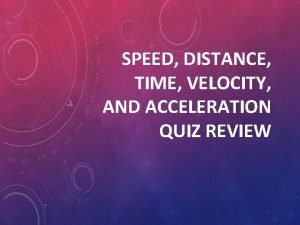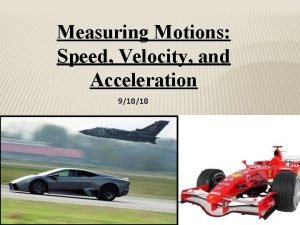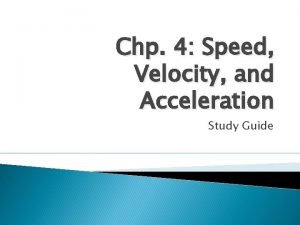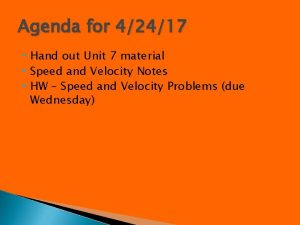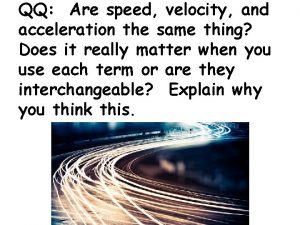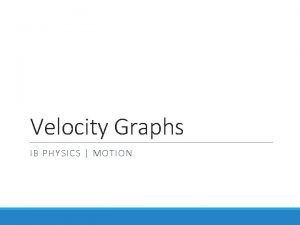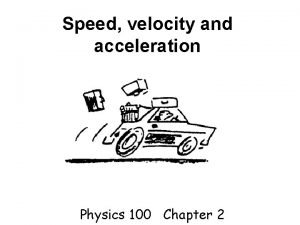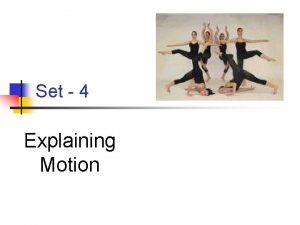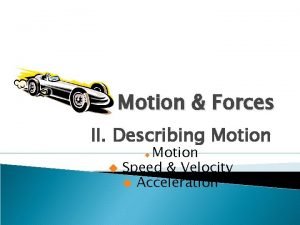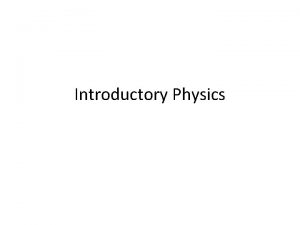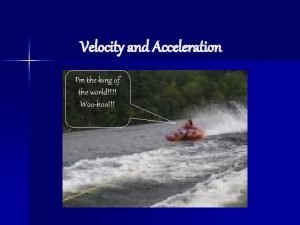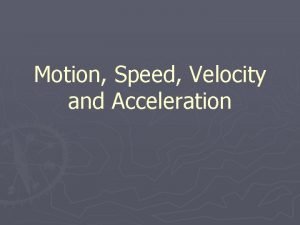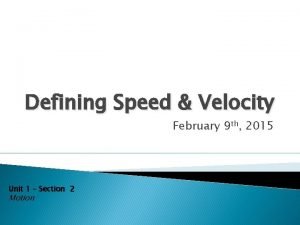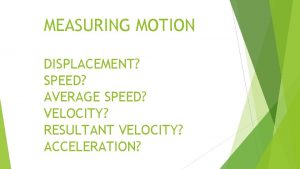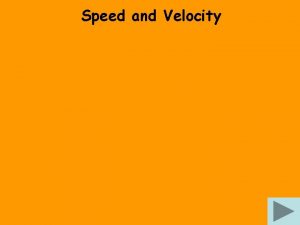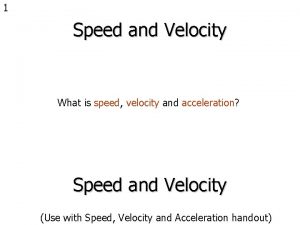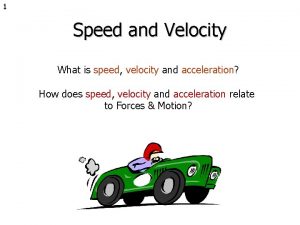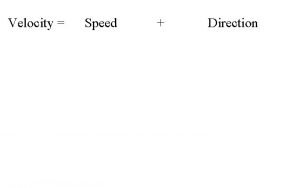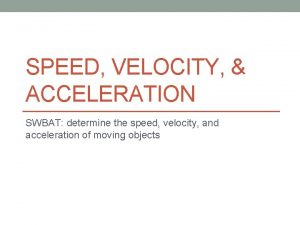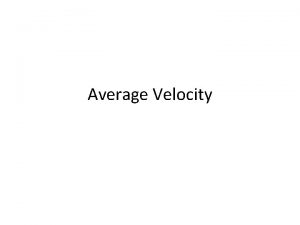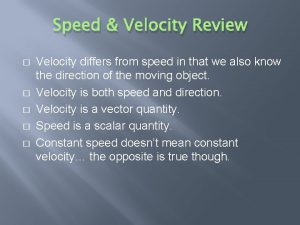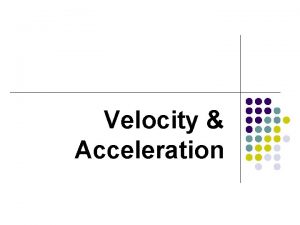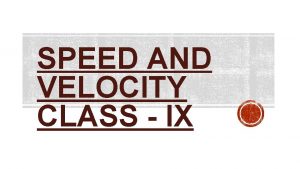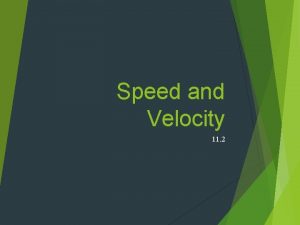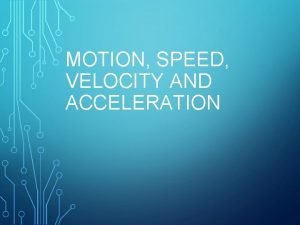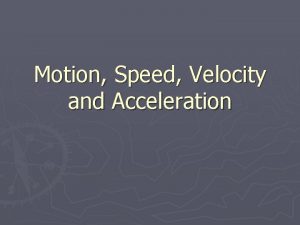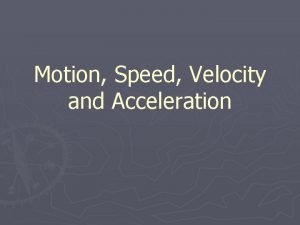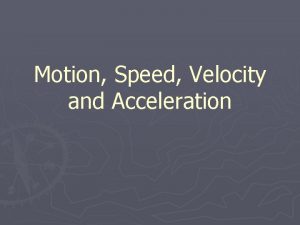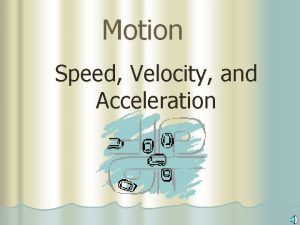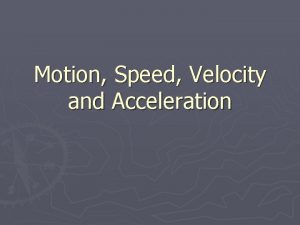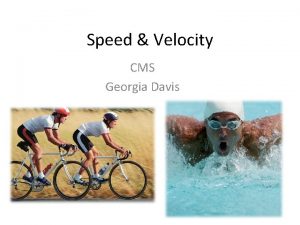Speed and Velocity Measuring motion What is Motion

























- Slides: 25

Speed and Velocity Measuring motion

What is Motion? ¡ An object’s change in position relative to a reference point. Point A Point B

Measuring Distance is the length traveled by an object. ¡ Meter – international unit for measuring distance. ¡ 1 mm = 50 m

Calculating Speed ¡ Speed (S) = distance traveled (d) / the amount of time it took (t). S = d÷t

Units for speed ¡ Depends, but will always be a distance unit / a time unit l l Ex. Cars: mi. /h Jets: km/h Snails: cm/s Falling objects: m/s

Calculating speed S = d/t If I travel 100 kilometer in one hour then I have a speed of… ¡ 100 km/h ¡ If I travel 1 meter in 1 second then I have a speed of…. ¡ 1 m/s ¡

Average speed ¡ Speed is usually NOT CONSTANT l l ¡ Ex. Cars stop and go regularly Runners go slower uphill than downhill Average speed = total distance traveled/total time it took.

Calculating Average Speed ¡ ¡ It took me 1 hour to go 40 km on the highway. Then it took me 2 more hours to go 20 km using the streets. Total Distance: l ¡ Total Time: l ¡ 40 km + 20 km = 60 km 1 h + 2 h = 3 hr Ave. Speed: l total d/total t = 60 km/3 h = 20 km/h

Question ¡ I ran 1000 m in 3 minutes. Then ran another 1000 m uphill in 7 minutes. What is my average speed? A) 100 m/min B) 2000 m/min Totall. Dist. = 1000 m + 1000 m = 2000 m l C) 10 m/min Totall. Time = 3 m/min + 7 min = 10 min D) 200 l E) 20 m/min Ave speed = total dist/total time = l 2000 m/10 min = 200 m/min = D

Velocity ¡ Velocity – the SPEED and DIRECTION of an object. l Example: An airplane moving North at 500 mph ¡ A missile moving towards a target at 200 m/s ¡

Question ¡ ¡ What is the difference between speed and velocity? Speed is just distance/time. Velocity includes direction as well.

Graphing Speed: Distance vs. Time Graphs Denver Phoenix

Question ¡ Below is a distance vs. time graph for 3 runners. Who is the fastest? Leroy is the fastest. He completed the race in 3 hours

Acceleration – the rate at which velocity changes l Can be an: Increase in speed ¡ Decrease in speed ¡ Change in direction ¡

Types of acceleration ¡ Increasing speed l ¡ Decreasing speed l ¡ Example: Car speeds up at green light screeeeech Example: Car slows down at stop light Changing Direction l Example: Car takes turn (can be at constant speed)

Calculating Acceleration ¡ If an object is moving in a straight line ¡ Units of acceleration: l m/s 2

Calculating Acceleration 0 s 0 m/s 1 s 4 m/s 2 s 8 m/s 3 s 12 m/s 4 s 16 m/s

Question ¡ A skydiver accelerates from 20 m/s to 40 m/s in 2 seconds. What is the skydiver’s average acceleration?

Now your turn…. Calculate the acceleration of a bus whose speed changes from 6 m/s to 12 m/s over a period of 3 s.

Positive Acceleration An object speeds up=acceleration in the same direction as the motion Ex. You are riding your bicycle in a straight line and speeded up from 4 m/s to 6 m/s in 5 s.

Negative Acceleration An object slows down=acceleration is in the direction opposite the motion Ex. You slow down on your bicycle from a speed of 4 m/s to 2 m/s in 5 s.

Graphing Acceleration: Speed vs. Time Graphs 1)Speed is increasing with time = accelerating 2)Line is straight = acceleration is constant Remember: in distance vs. time graphs: curved line = accelerating, flat line = constant speed

Question: 1) Which line represents an object that is accelerating? 2) Which line represents positive acceleration? 3) Which line represents negative acceleration? 4) Which line is the acceleration constant?


 Angular vs linear velocity
Angular vs linear velocity Initial velocity and final velocity formula
Initial velocity and final velocity formula Ms-1
Ms-1 Speed and velocity quiz
Speed and velocity quiz Speed, velocity and acceleration problems
Speed, velocity and acceleration problems What is the difference between speed and velocity
What is the difference between speed and velocity Increasing speed distance time graph
Increasing speed distance time graph How is velocity different from speed
How is velocity different from speed Velocity describes
Velocity describes Velocity acceleration distance formula
Velocity acceleration distance formula Speed velocity and acceleration study guide answers
Speed velocity and acceleration study guide answers Speed challenge lab
Speed challenge lab Are speed velocity and acceleration the same thing
Are speed velocity and acceleration the same thing Youtube https //www.youtube.com/watch v=vnp84pn0mjq
Youtube https //www.youtube.com/watch v=vnp84pn0mjq Describing and measuring motion
Describing and measuring motion Speed, velocity and acceleration notes
Speed, velocity and acceleration notes Chapter 1 lesson 2 speed and velocity answer key
Chapter 1 lesson 2 speed and velocity answer key What is velocity
What is velocity Velocity and speed
Velocity and speed Speed and velocity difference
Speed and velocity difference Do heavier things fall faster
Do heavier things fall faster How to describe speed
How to describe speed Velocity describes both speed and
Velocity describes both speed and Speed and velocity
Speed and velocity Speed and velocity
Speed and velocity Comparing distance/time graphs to speed/time graphs
Comparing distance/time graphs to speed/time graphs



